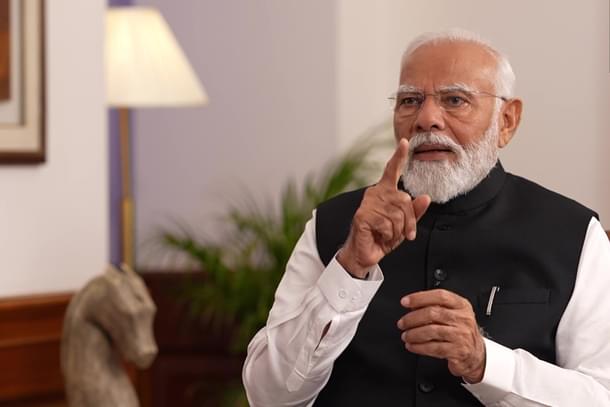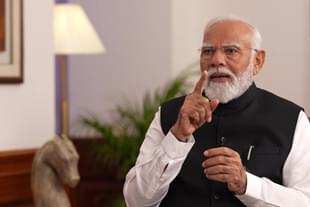Ideas
The Development Versus Hindutva Debate Is Wrong And Even Dishonest
Praful Shankar
May 13, 2024, 02:02 PM | Updated May 14, 2024, 01:07 PM IST
Save & read from anywhere!
Bookmark stories for easy access on any device or the Swarajya app.


Listening to the recent episode of Smita Prakash’s podcast featuring former Union minister Praful Patel offered a fascinating glimpse into the evolution of the Nationalist Congress Party (NCP).
From its origins as a splinter group of the Congress to becoming one of its staunchest allies, and eventually splintering into two factions, Patel's insights shed light on the intricate dynamics within the party.
Particularly interesting were his perspectives on the inner workings of the rather enigmatic party that is the NCP and its two main leaders — Sharad Pawar and his now estranged nephew Ajit.
Equally compelling was Patel's reflection on his own personal journey, transitioning from the camp of his mentor, Sharad Pawar, to aligning with the Ajit faction.
Political watchers will remember how we witnessed the irony of Patel initially accompanying senior Pawar to the inaugural meeting of the INDI Alliance, only to swiftly join Ajit Pawar and subsequently, the NDA in just a matter of days.
In his description of these events, Patel delineates a stark contrast between India's major political blocs, emphasising the influence of the Prime Minister within the NDA.
He vividly characterises the INDI Alliance meeting as aimless and lacking a cohesive national agenda beyond the removal of Narendra Modi from office.
In contrast, he depicts the Bharatiya Janata Party-led coalition as propelled by a clear agenda, rooted in the Prime Minister's vision for advancing the nation & especially his developmental agenda.
Now, none of this should surprise even a casual observer of Indian politics. Over the last decade, there has been a significant leap in advancements across the nation in areas such as infrastructure, technology, and the broader business environment.
In many of these domains, the Modi government has proven to be a worthy successor to the Atal Bihari Vajpayee regime, remembered for its emphasis on developmental projects during its six-year tenure.
However, one cannot resist the urge to scrutinise these facts in light of the well-worn dichotomy often posed by the political commentariat: Development versus Hindutva.
The framing of this question, skilfully crafted by self-proclaimed 'progressive' journalists and commentators, is a subtle and covert attempt to portray the BJP, India's primary proponent of Hindutva, as inherently opposed to development.
Consequently, it also insinuates that the BJP's chief rival, the Congress party, represents the forces of progress and development.
For decades, the Congress-leaning ecosystem successfully peddled this narrative to the Indian public.
The shield employed for this purpose was Dr Manmohan Singh and the reforms he implemented during his tenure as finance minister in the P V Narasimha Rao government.
Whether these groundbreaking reforms were driven by the Congress’ convictions, or the exigencies of desperate times remains a matter of debate, but that discussion is best left for another day.
However, the facade concealing the Congress' history of promoting regressive economic practices has been shattered in recent months.
One after another, prominent figures from the Congress, including the party’s leader Rahul Gandhi, have outlined their vision for India, centred around misguided ideas such as wealth redistribution and inheritance tax.
When viewed alongside the Soviet-inspired policies of Rahul's great-grandfather Pandit Nehru and his grandmother, Indira Gandhi, this paints a concerning picture of the outlook of the second biggest political party of the country.
Furthermore, it provides a lucid understanding of which political factions and ideologies in India genuinely advocate for its material advancement.
This comprehension holds significant importance — recognising that cultural progress can coexist with material progress, or as commonly expressed in Indian context, that development need not clash with Hindutva.
Indeed, one can take it a step further and assert that the aspiration for a developed and industrially modernised India has been integral to the Hindutva movement from its inception.
Beginning with the architect of the movement, Vinayak Damodar Savarkar, who championed the cultivation of a scientific mindset and rapid industrial modernisation with the aim of fostering prosperity for the common Indian, to the accomplishments of the two Hindutva-led governments in India, the empirical evidence is unmistakable.
The internationalist perspective often embraced by leftist ideologies tends to oversimplify the complex tapestry of nations and their citizens, often reducing them to mere categories of oppressors and victims.
In doing so, it overlooks the profound significance of intrinsic cultural inclinations and the untapped entrepreneurial spirit of ordinary citizens.
This approach imposes a rigid, one-size-fits-all worldview onto diverse societies, disregarding their unique histories, traditions, and aspirations.
Consequently, it not only erodes the rich cultural legacies that define each nation but also stifles the flourishing of the distinctive characteristics that make them special.
In stark contrast, history illustrates that political movements deeply rooted in the land and its heritage have proven most effective in advancing the interests of their respective nations.
In the Indian context, the failures stemming from Nehru's steadfast adherence to a foreign model, devoid of cultural resonance, highlight the importance of aligning policies with the cultural fabric of a nation.
Similarly, the disconnect between Rahul Gandhi's advocacy for Scandinavian economic models and the sentiments of the broader Indian public underscores the significance of political movements grounded in indigenous values and experiences.
The significance of cultural connection becomes increasingly paramount for contemporary India — a nation that inherits the legacy of an ancient civilisation yet stands as a young entity in the modern global context, still striving to carve out its niche on the global stage.
Discerning the type of leadership capable of unlocking the nation's full potential will be a pivotal question that the Indian public will have to grapple with repeatedly in the coming decades.
India's distinct cultural heritage and its burgeoning economic prowess will face continual scrutiny in an increasingly uneasy global landscape. The allure of adhering to prevailing global liberal norms will often seem a convenient solution for a populace generally averse to conflict.
Fortunately, the present political environment has rendered the decision relatively clear-cut for the Indian public.
However, in the grander scheme of things, India's destiny will hinge upon the extent to which its citizens can sift through the noise and grasp the fundamental truth that enduring nations can only be forged by leaders who honour the cultural fabric of the land and foster a deep emotional connection with it.
Praful Shankar is a political enthusiast and tweets at @shankarpraful.





